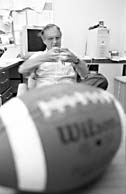
Comment
on this story
Introduction
Guys & Vols
Brooks Clark's annual predictions for the season to come.
Then Again...
Eh, what does that Brooks guy know, anyway? Adrienne Martini and Joey Cody offer the 2000 Chicks' Picks.
Blue-Bloods
Mike Gibson takes a look at Tennessee Titans fans.
Managing Success
Matthew T. Everett talks to the man behind the curtain.
The Fizzicks of Football
|
|

Who says academics and athletics don't mix?
by Jesse Fox Mayshark
Sometimes it seems like there are two UTs—the one with the gridiron team and the big stadium, and the other obscure one with all those buildings and diploma thingys and strange jargon like "students," "faculty," and "all-nighters."
It turns out there is some connection between the disparate entities. After extensive consultation with Dr. William Bugg of the UT Physics Department, Metro Pulse is pleased to report that, in addition to dubious distinctions like exploring the nature of reality and the origins of the cosmos, science has a practical application: Football. Herewith, Dr. Bugg's tutorial on the properties of the pigskin. Pay special attention to the highlighted terms. There will be a test.
[Ed. Note: Dr. Bugg claims no expertise in football, other than a fruitless spring practice season with the Oak Ridge High School team, a few years as a Little League Football coach, and UT season tickets since 1959. He notes, however, that his son was responsible for what was possibly the last recorded drop-kick in Knoxville Catholic High School history. Also, his name really is Dr. Bugg, he never wanted to be an entomologist, and yes, he has heard that one before.]
"There are basically two kinds of things you have to worry about. One is the flight of the football, the passing and kicking game. And the other is the science of collisions. Let's start with the football.
"First, it is a prolate spheroid. It's an oblong object that has an axis of symmetry you can rotate it around. It has a long axis."
Passing: "If there were no air at all, if there were no air in Neyland Stadium, it wouldn't make any difference how you threw a football. Of course, there might not be any football players then, either, but...Most of what's involved in passing is minimizing air resistance. For any object, streamlining is the key to minimizing air resistance."
[Here, Dr. Bugg illustrates with the assistance of a Wilson football, gripping it toward the back and pointing its nose straightforward. But there's more.]
"If you don't spin it, it would be unstable...You have to give it angular momentum. You do that by giving it rotation around its long axis. So the idea of making a football go the longest distance is giving it angular momentum: the faster it rotates, the more velocity it has, the farther it goes."
Punting: "The same principle is involved in punting. A really good kicker kicks it off his instep and tries to give it a spiral. Of course, you make it go a lot faster when you kick it than when you throw it."
Place-kicking: "The drop-kickers used to do the same kind of kicking as punters...The reason people don't drop-kick any more is because the ball's a different shape. The ends used to be much rounder. If you dropped it, it would bounce back up...[But with the new ball,] there's just no way you can put your foot on it to make it do that. So the kickers try to make it stable. They can't rotate around the long axis, so they rotate it around the short axis. A place-kicker's foot hits the football two or three inches below the center and two or three inches above the ground. That imparts a backward rotation to it, and that backward rotation [the end-over-end spin of a field goal or extra point kick] is what makes the football's flight as stable as it is."
Tackles: "The physics of collisions is a little more obvious than the flight of the football. There are basically two kinds of collisions: an elastic collision, and what we call an inelastic collision. In football, almost all your collisions are inelastic...In an elastic collision, energy is conserved. In an inelastic collision, energy is not conserved. It goes into heat, literally. It goes into sweat."
[To visualize this, imagine a 250-pound left tackle hammering a 198-pound running back. In an elastic collision, they would bounce off each other. In an inelastic collision, they stick together. Whether or not they stop, of course, depends on the skill of the participants.]
"To stick together and stop, they have to have the same momentum, which is their mass times velocity...You can see why size and speed are the important things."
Pads: "Pads basically protect you. How? They protect you buy spreading the force out. A shoulder pad distributes that force over a fairly large portion of your body...The body is essentially a bunch of physics levers connected together by muscles. There are directions [in which] those levers are very strong, and others where they're weak."
Any questions? Look for Dr. Bugg somewhere above the 20-yard line.
Class dismissed.

August 31, 2000 * Vol. 10, No. 35
© 2000 Metro Pulse
|





